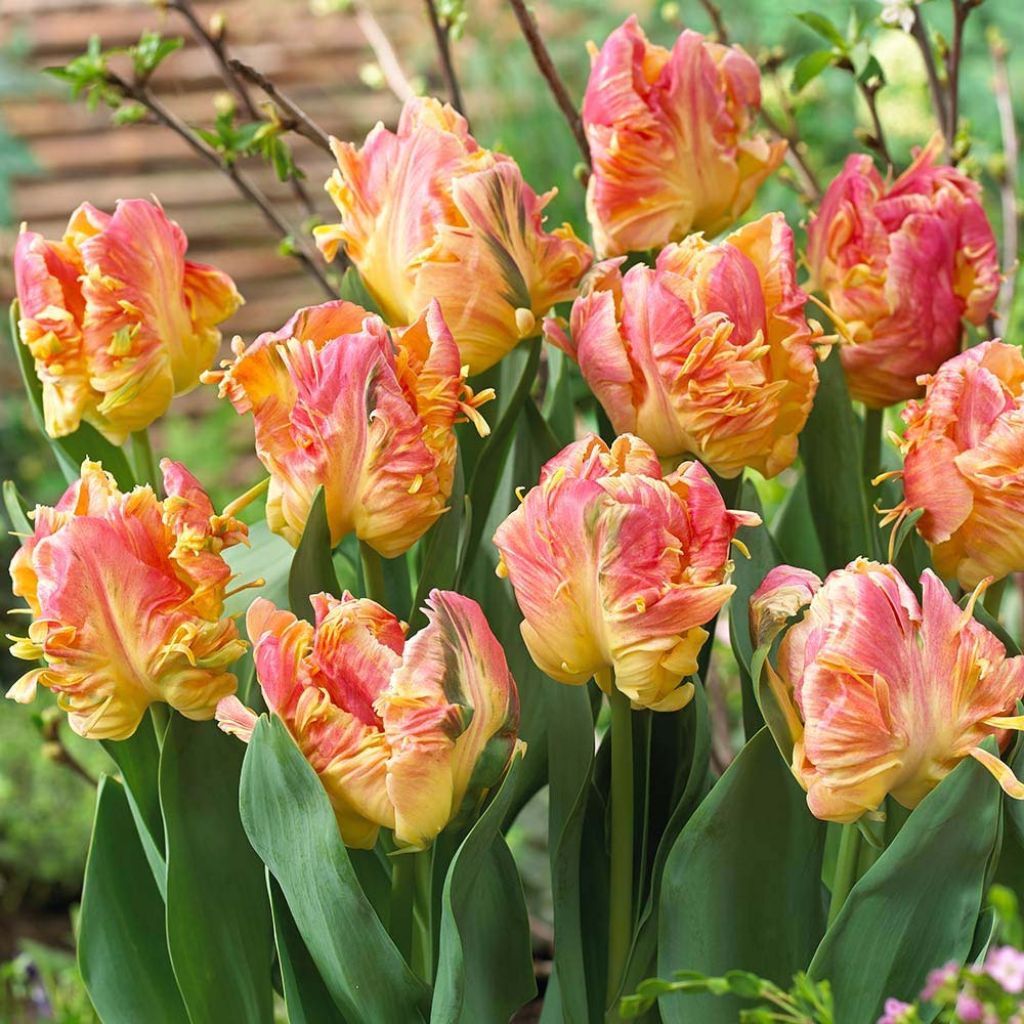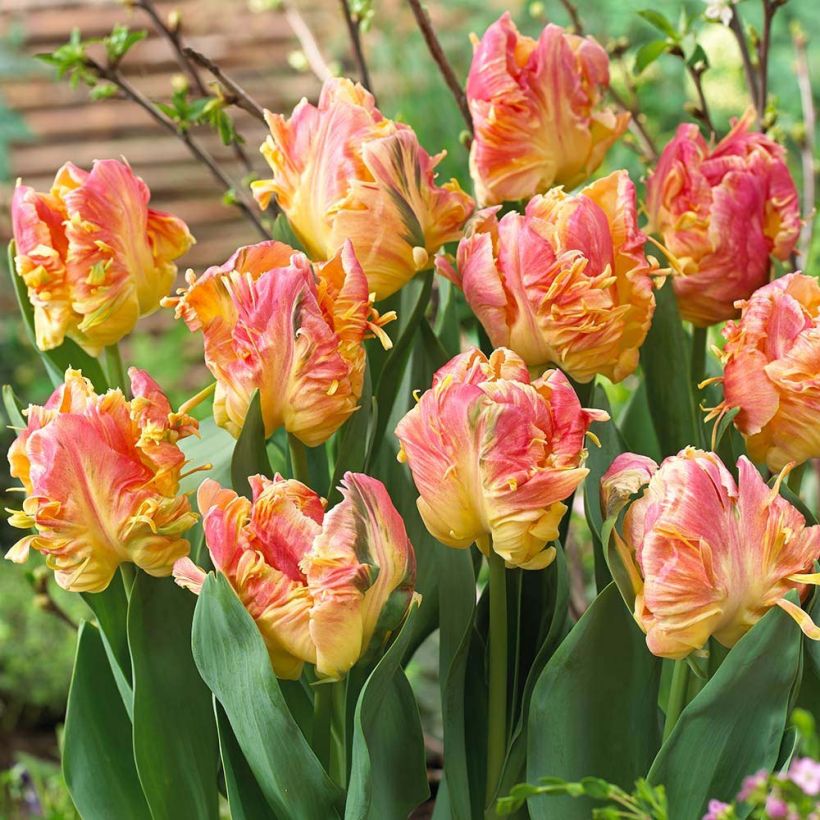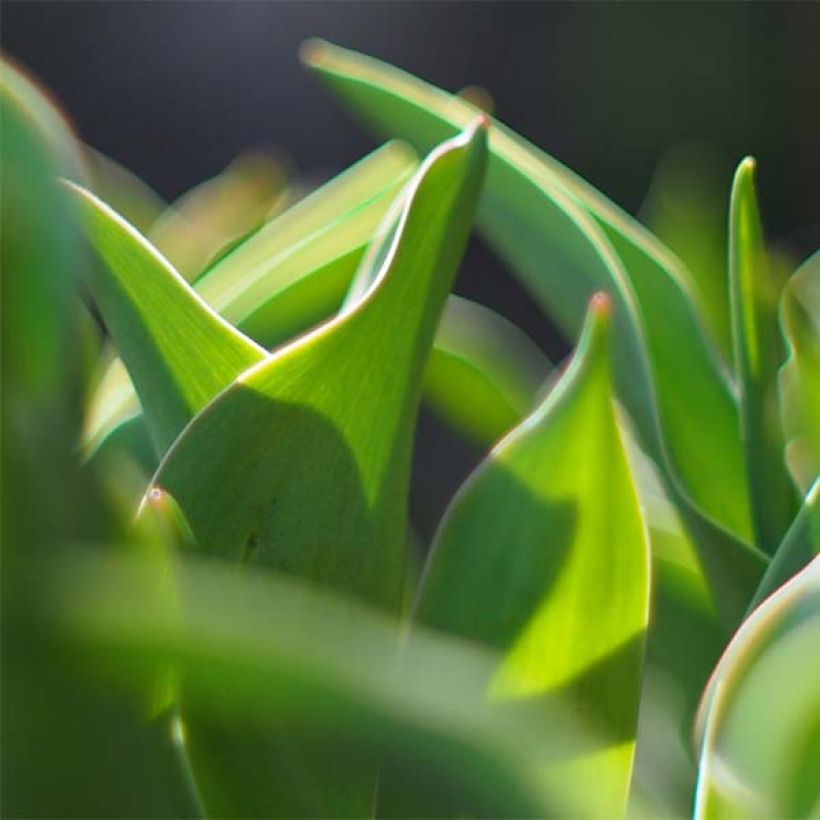

Tulipe Perroquet Parrot Lady*
Tulipa 'Parrot Lady'
Tulipa Parrot Lady
This plant carries a 6 months recovery warranty
More information
We guarantee the quality of our plants for a full growing cycle, and will replace at our expense any plant that fails to recover under normal climatic and planting conditions.
From €5.90 for pickup delivery and €6.90 for home delivery
Express home delivery from €8.90.
Does this plant fit my garden?
Set up your Plantfit profile →
Description
The 'Parrot Lady' tulip is a hard-to-find variety that will charm fans of chic and baroque flowers. With its fringed and twisted petals in a very bright apricot pink colour, splashed with yellow-orange tones, in a shiny texture that reflects light well, it doesn't go unnoticed in the garden, and its sturdy stems withstand bad weather. Its intensely coloured flowering catches the eye in the borders in April-May. The charm also works in a vase, when it is integrated into a bouquet inspired by the baroque style.
The 'Parrot Lady' Tulip belongs to the Liliaceae family. Originally horticultural, it is currently classified in the group of 'Parrot tulips', whose main characteristic is to have huge flowers with twisted, puffed up, tousled, irregularly fringed petals. 'Parrot Lady' is also obtained by mutation (sudden appearance of new characteristics that are maintained in subsequent generations). It is of medium size (40cm (16in)), carried by a thick and sturdy stem, and its flower is of a beautiful size. It stands out for its ability to reflect light, bringing to life the warm flamed apricot pink colour of its petals under a unique glaze. The original shape of the parrot tulip adds an additional charm, making this flower anything but monotonous, especially when its buds slowly open in a vase, almost ceremoniously. The flowering takes place in April-May, at the heart of the tulip and garden iris season.
Richness of colours, stunning and variegated flowers, usable both in borders and to enhance your bouquets, the reputation of parrot tulips is well established. In the 18th century, they were called 'monstrous'; this group developed a lot in the 1930s, when it was discovered that irradiating bulbs with X-rays caused this mutation. Already, they are among the most planted varieties. Unmatched for bringing fantasy to pots or sunny gardens, don't forget to consider the height and flowering period when designing your borders, as these parameters vary significantly from one cultivar to another. It is wise to plant a few more bulbs for cutting, as they make beautiful cut flowers that last a long time in a vase.
Report an error about the product description
Tulipa 'Parrot Lady' in pictures




Plant habit
Flowering
Foliage
Botanical data
Tulipa
Parrot Lady
Liliaceae
Cultivar or hybrid
Planting and care
How to plant my tulips? Plant your tulips as soon as possible in a well-drained soil. Loosen the soil deeply. Plant at a depth of 15cm (6in) (Bulbs should be covered with twice their height of soil). Space the bulbs a few cm apart, ensuring they do not touch each other. Choose a sunny location for better flowering. After flowering, cut the flower stalks and allow the leaves to dry completely before cutting them. After flowering, their foliage becomes unsightly and faded. We recommend planting Heuchera, Foamflowers, Brunneras, Bleeding Hearts, Cypress Spurge, in the forefront of your flower beds, their foliage will enhance the colours of your tulips and throughout the season, they will elegantly conceal their yellowed leaves.
Planting period
Intended location
Care
This item has not been reviewed yet - be the first to leave a review about it.
Haven't found what you were looking for?
Hardiness is the lowest winter temperature a plant can endure without suffering serious damage or even dying. However, hardiness is affected by location (a sheltered area, such as a patio), protection (winter cover) and soil type (hardiness is improved by well-drained soil).

Photo Sharing Terms & Conditions
In order to encourage gardeners to interact and share their experiences, Promesse de fleurs offers various media enabling content to be uploaded onto its Site - in particular via the ‘Photo sharing’ module.
The User agrees to refrain from:
- Posting any content that is illegal, prejudicial, insulting, racist, inciteful to hatred, revisionist, contrary to public decency, that infringes on privacy or on the privacy rights of third parties, in particular the publicity rights of persons and goods, intellectual property rights, or the right to privacy.
- Submitting content on behalf of a third party;
- Impersonate the identity of a third party and/or publish any personal information about a third party;
In general, the User undertakes to refrain from any unethical behaviour.
All Content (in particular text, comments, files, images, photos, videos, creative works, etc.), which may be subject to property or intellectual property rights, image or other private rights, shall remain the property of the User, subject to the limited rights granted by the terms of the licence granted by Promesse de fleurs as stated below. Users are at liberty to publish or not to publish such Content on the Site, notably via the ‘Photo Sharing’ facility, and accept that this Content shall be made public and freely accessible, notably on the Internet.
Users further acknowledge, undertake to have ,and guarantee that they hold all necessary rights and permissions to publish such material on the Site, in particular with regard to the legislation in force pertaining to any privacy, property, intellectual property, image, or contractual rights, or rights of any other nature. By publishing such Content on the Site, Users acknowledge accepting full liability as publishers of the Content within the meaning of the law, and grant Promesse de fleurs, free of charge, an inclusive, worldwide licence for the said Content for the entire duration of its publication, including all reproduction, representation, up/downloading, displaying, performing, transmission, and storage rights.
Users also grant permission for their name to be linked to the Content and accept that this link may not always be made available.
By engaging in posting material, Users consent to their Content becoming automatically accessible on the Internet, in particular on other sites and/or blogs and/or web pages of the Promesse de fleurs site, including in particular social pages and the Promesse de fleurs catalogue.
Users may secure the removal of entrusted content free of charge by issuing a simple request via our contact form.
The flowering period indicated on our website applies to countries and regions located in USDA zone 8 (France, the United Kingdom, Ireland, the Netherlands, etc.)
It will vary according to where you live:
- In zones 9 to 10 (Italy, Spain, Greece, etc.), flowering will occur about 2 to 4 weeks earlier.
- In zones 6 to 7 (Germany, Poland, Slovenia, and lower mountainous regions), flowering will be delayed by 2 to 3 weeks.
- In zone 5 (Central Europe, Scandinavia), blooming will be delayed by 3 to 5 weeks.
In temperate climates, pruning of spring-flowering shrubs (forsythia, spireas, etc.) should be done just after flowering.
Pruning of summer-flowering shrubs (Indian Lilac, Perovskia, etc.) can be done in winter or spring.
In cold regions as well as with frost-sensitive plants, avoid pruning too early when severe frosts may still occur.
The planting period indicated on our website applies to countries and regions located in USDA zone 8 (France, United Kingdom, Ireland, Netherlands).
It will vary according to where you live:
- In Mediterranean zones (Marseille, Madrid, Milan, etc.), autumn and winter are the best planting periods.
- In continental zones (Strasbourg, Munich, Vienna, etc.), delay planting by 2 to 3 weeks in spring and bring it forward by 2 to 4 weeks in autumn.
- In mountainous regions (the Alps, Pyrenees, Carpathians, etc.), it is best to plant in late spring (May-June) or late summer (August-September).
The harvesting period indicated on our website applies to countries and regions in USDA zone 8 (France, England, Ireland, the Netherlands).
In colder areas (Scandinavia, Poland, Austria...) fruit and vegetable harvests are likely to be delayed by 3-4 weeks.
In warmer areas (Italy, Spain, Greece, etc.), harvesting will probably take place earlier, depending on weather conditions.
The sowing periods indicated on our website apply to countries and regions within USDA Zone 8 (France, UK, Ireland, Netherlands).
In colder areas (Scandinavia, Poland, Austria...), delay any outdoor sowing by 3-4 weeks, or sow under glass.
In warmer climes (Italy, Spain, Greece, etc.), bring outdoor sowing forward by a few weeks.


































